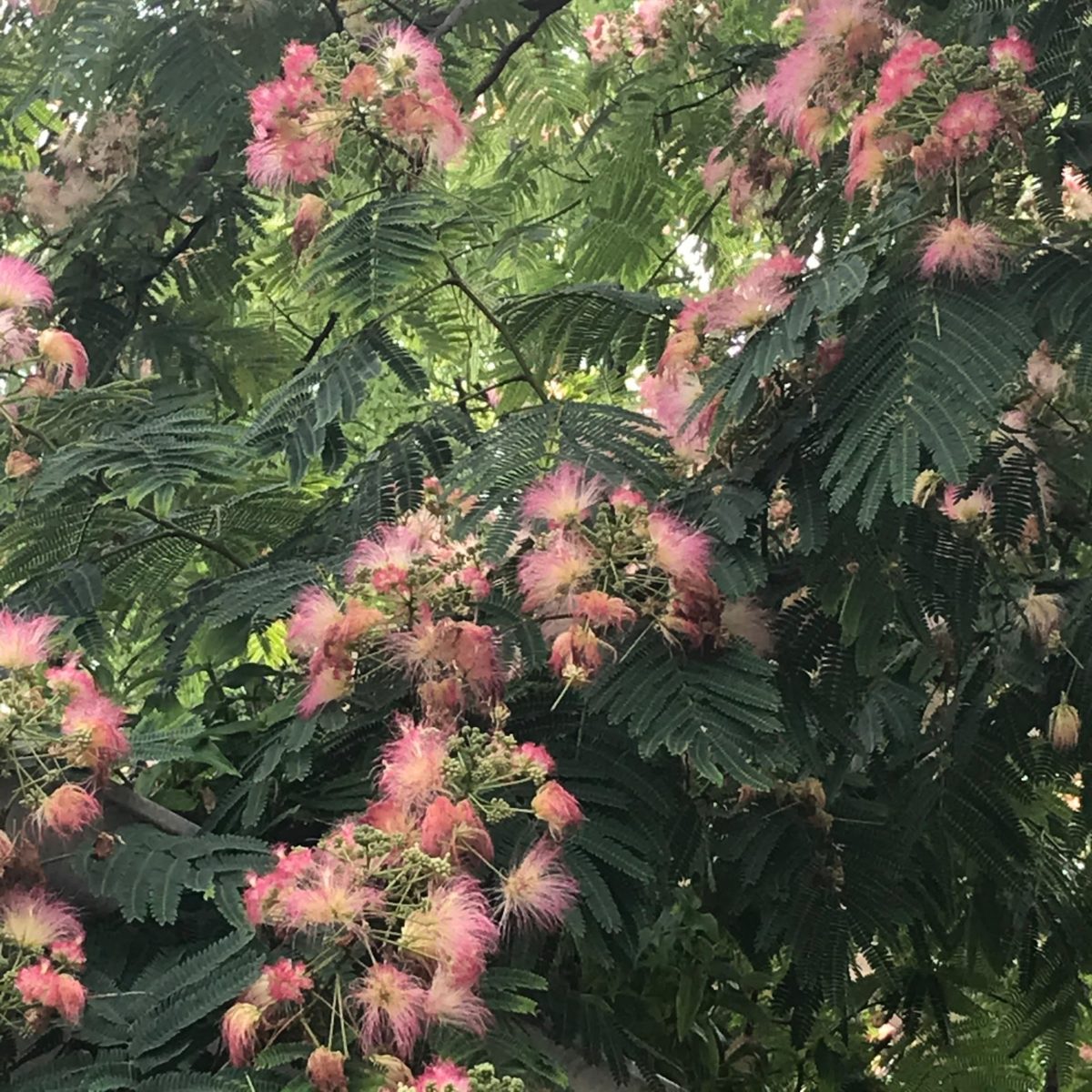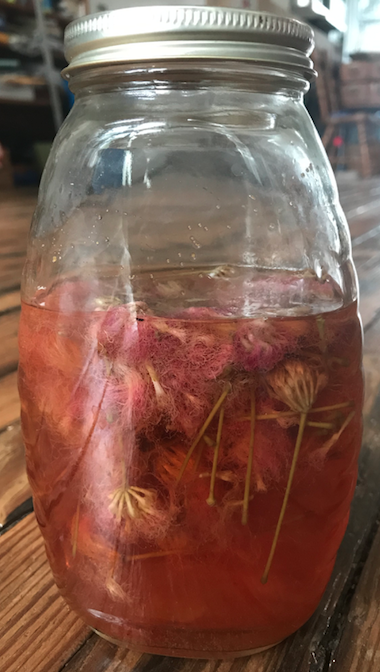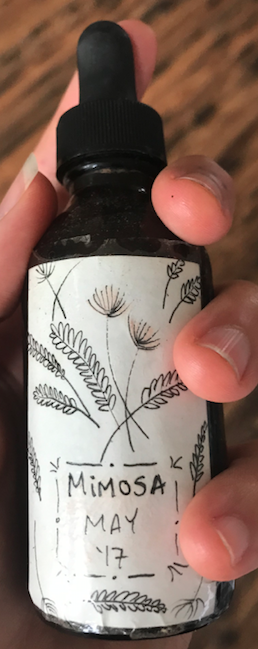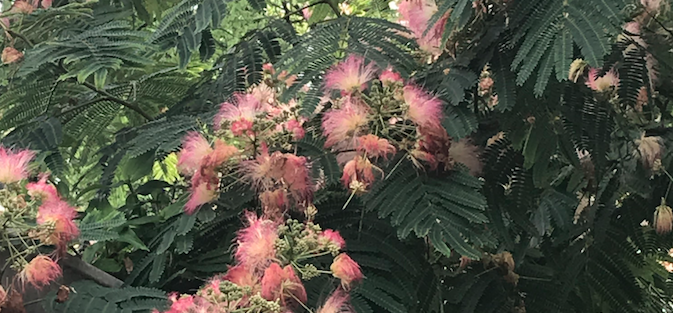Have you ever noticed fuzzy pink, silky stranded flowers in trees around the end of June and beginning of July? Did you know that they are edible and medicinal? Let’s learn a bit more!
Firstly, it is important to note that these blog posts are meant to bring and expand these plants into our awareness. Please make sure that you are 100% sure of what you find before you harvest and ingest. Also, as mentioned in previous blog posts about the economy of reciprocity, please be mindful of how much you harvest and where you harvest–leaving enough for other people, animals, and insects to harvest–and for the trees to regenerate. It’s important to appreciate the tree and the ecosystem it is a part of, that we are a part of. Be gentle with the tree, itself! After all, this tree is related to the “sensitive touch plant,” but does not shrink with touch.
Okay, so what is this tree? What are these flowers? The tree goes by many names. Persian Silk Tree, Chinese Silk Tree, and Mimosa Tree (like the sensitive touch plant, not like the orange juice/champagne drink…though perhaps you could get creative here!). The scientific name is Albizia julibrissin. I have heard it referred to as Mimosa the most in the Mid-Atlantic region, so that is what I will refer to the tree as in this post. The Mimosa Tree originates in Iran, spread throughout China and Korea, and generally lives in parts of southern Asia. It was introduced to Europe, and later North America, sometime in the mid-18th century. It has become so prolific in North America that it is considered to be an invasive species in the southern United States. I have three full-sized (40 feet tall!) Mimosa Trees in my alley-way in Baltimore. Please be on the lookout for a future blog post concerning three major classifications of plants “native,” “naturalized,” and “invasive,” and how complicated this is through an ecological and philosophical standpoint. One way of cutting back the impact of invasive species and to be engaged with their gifts through responsibly foraging!
Out in the woods and on street corners, you’ll notice these deciduous trees by their almost fern-like leaves and pink, silky flowers that fan out from the calix/base. The pink silky parts are actually the stamens, or the part of the plant that holds pollen and often has a filament and anther (think of the middle bits in a lily flower, for example). The trees make themselves known by their striking and flamboyant appearance, and by the flowers that they drop on the ground. The leaves are tripinnate with about 6-12 leaflet pairs on either side of the main stem, and another leaflet set on each of those pairs (in a 3 level fractal). They appear as a crown of fanning, arching leaves. The bark is a dark greenish-brown color. Mimosa Trees are a great companion to bees and other pollinators, and because it is sometimes incorporated as an ornamental tree, would be a great addition to a pollinator garden.
Please see some identification pictures below:

You can technically harvest early spring leaves to boil into stews or sauteed in different dishes, though the flowers and the bark are used more often as medicine. Traditional Chinese medicine and acupuncture uses both parts of the plant to treat insomnia, depression, and grief, and is often prepared into a tea. It is called “He Huan Hua.” He Huan Hua is associated with pleasure and collective happiness. I have heard from herbalist friends that they notice a potential harmful interaction between Mimosa Tree bark medicine with those who experience Bi-Polar Disorder, so please be aware and careful of that (in addition to the caution used with foraging and medicine making). Within my experience, I only harvest the flowers for medicine. I tend to harvest the flowers towards the bottom of the tree within my reach, and harvest the most perky and defined flowers. As the season progresses, flowers start to wilt and fall into a tangle, or continue their process into forming seeds. Once the flowers have defined seeds, DO NOT harvest them. The mature seeds have some toxic properties. The slender pink petals start to fall away and a legume-like seed pod emerges in it’s place.
Please harvest the flowers when they look like this:
You can use the flowers to make a tea, or you can make tinctures, oxymels, and other infusions to ingest. My favorite way to make medicine with Mimosa flowers is through an oxymel. Oxymel literally means vinegar-honey in Latin. I personally prefer this to tinctures because alcohol isn’t involved. Oxymels tend to be made with apple cider vinegar. This is a basic oxymel recipe from Mountain Rose Herbs that I use as a guideline. When I’m in a brain fog or need an energy boost, I take 3 drops at a time, and I don’t exceed 5 in a day. Other blogs and other recipes will have other prescriptions.
For my 2020 Mimosa Oxymel, I used equal parts Mimosa Flowers, raw local honey, and raw Apple Cider Vinegar:

Here are some other ways to use Mimosa Flowers:
Mimosa Tincture and Mimosa Blackberry Cordial
Below is some inspiration for how to label your Mimosa tincture or oxymel when in it’s final form. My friend gifted me this tincture a few years ago…I’ve kept the bottle because I like it. Please note that tinctures and oxymels start to lose their potency after one year:

Thank you for reading! Let us know if you see Mimosa Trees around Maryland by taking a picture and tagging us on facebook or @marylandnature on instagram.
And a last reminder…please do more research beyond this point if you are interested in making tea, medicine, or food with Mimosa!

